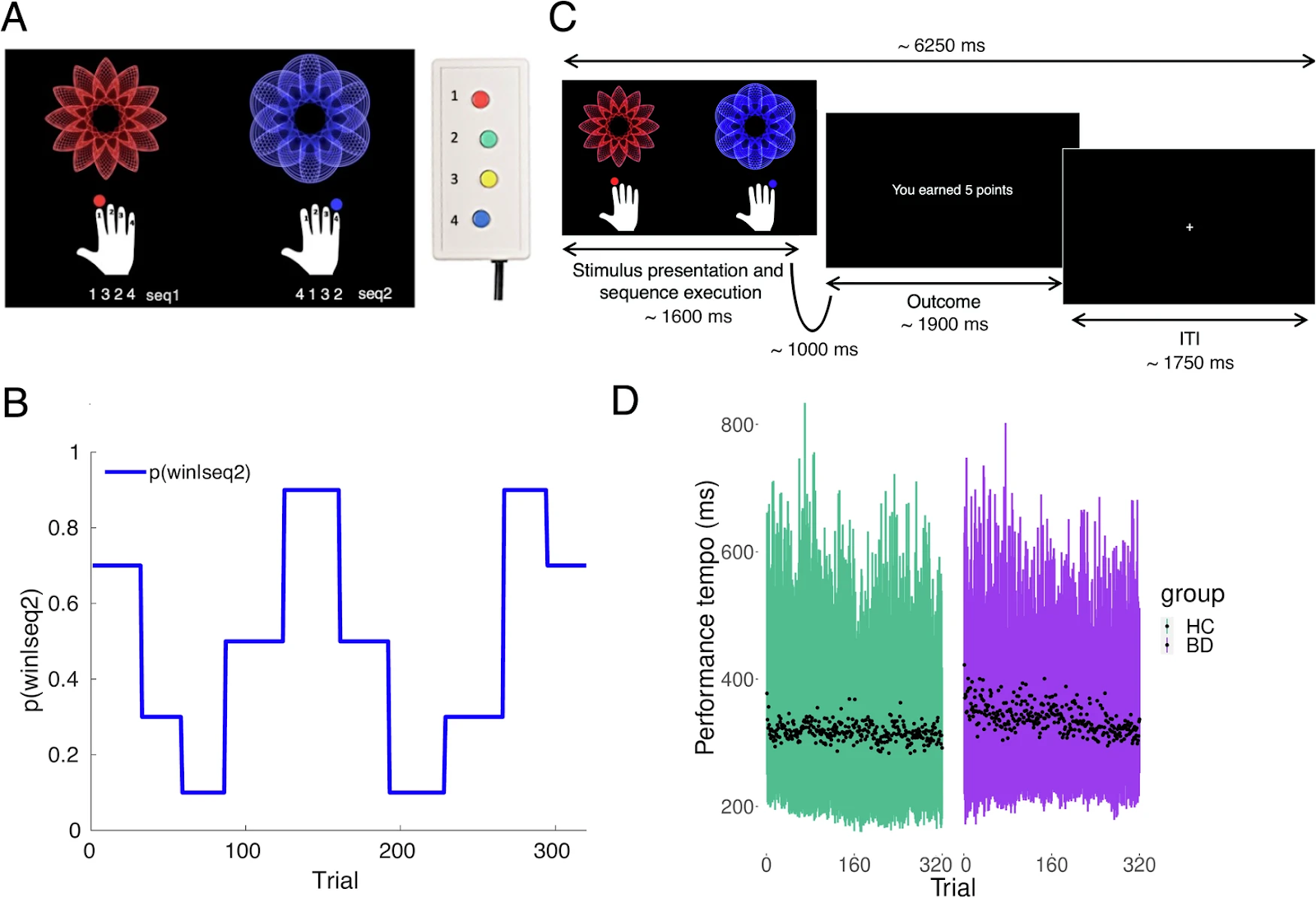Scientists Reveal Cognitive Mechanisms Involved in Bipolar Disorder

An international team of researchers including scientists from HSE University has experimentally demonstrated that individuals with bipolar disorder tend to perceive the world as more volatile than it actually is, which often leads them to make irrational decisions. The scientists suggest that their findings could lead to the development of more accurate methods for diagnosing and treating bipolar disorder in the future. The article has been published in Translational Psychiatry.
Bipolar disorder (BD) is a chronic affective condition characterised by alternating episodes of extreme elation (mania) and severe depression. According to the WHO, an estimated 40 million people worldwide live with bipolar disorder, but diagnosing the condition can be challenging, as its symptoms are not always apparent.
Studies show that individuals with bipolar disorder, even during remission, exhibit specific behavioural and brain activity patterns that may indicate the condition. In particular, patients with bipolar disorder have been found to exhibit impairments in their decision-making processes. Normally, when making a decision, a person tries to choose the option that offers the greatest reward. If the choice proves to be correct, they are likely to make the same decision again next time. However, circumstances can change, requiring a person to reassess which option offers the greatest benefit. Patients with BD often struggle to recognise when it is necessary to adjust their decision-making strategy.
A group of researchers from HSE University, Sechenov University, the Max Planck Institute, and Goldsmiths, University of London, conducted an experiment to investigate how individuals with bipolar disorder adapt to environmental changes and make decisions.
The study included 22 bipolar patients in remission and 27 healthy volunteers who served as the control group. Participants were instructed to earn as many points as possible by selecting either a blue or red image on a computer screen. Each option had a certain probability of winning, which changed throughout the experiment. For example, initially the blue image won 70% of the time, but later its winning probability dropped to 30%. Throughout the experiment, participants’ neuronal brain activity was monitored using magnetoencephalography (MEG).

Marina Ivanova
'This experimental design mimics real-world conditions, which are also full of uncertainties and require constant decision-making—even in everyday situations. For example: should you pet a cat, or is it better not to? Will it purr or scratch? We try to anticipate the consequences of our choices and make the best decision accordingly,' explains Marina Ivanova, Junior Research Fellow at the HSE Institute for Cognitive Neuroscience and primary author of the study.

The results of the experiment showed that participants with bipolar disorder perceived the environment as more volatile than it actually was, which often led them to make incorrect choices.
'If a person makes a decision and it turns out to be the right one, they will likely repeat that choice next time. However, someone with bipolar disorder may change their strategy even after a successful outcome,' says Ivanova.
The scientists also observed neural differences in brain regions involved in decision-making, specifically the medial prefrontal, orbitofrontal, and anterior cingulate cortices. At the neural level, while healthy individuals exhibited alpha-beta suppression and increased gamma activity during the experiment, participants with bipolar disorder showed dampened effects.
'Our study reveals that even outside of manic or depressive episodes, people with bipolar disorder process information about environmental changes differently. They constantly anticipate changes but struggle to properly learn from them when they occur. As a result, their decisions are more spontaneous and unpredictable than those of the control group,' comments Ivanova. ‘However, it is important to remember that our experiment only simulates real life, so we should be cautious when applying these findings to actual everyday situations.'
The results may be useful for developing models to diagnose bipolar disorder and predict its recurrence. In the future, this approach could be adapted to other mental health conditions involving adaptive learning impairments and may also serve as an important step toward advancing computational psychiatry.
See also:
Larger Groups of Students Use AI More Effectively in Learning
Researchers at the Institute of Education and the Faculty of Economic Sciences at HSE University have studied what factors determine the success of student group projects when they are completed with the help of artificial intelligence (AI). Their findings suggest that, in addition to the knowledge level of the team members, the size of the group also plays a significant role—the larger it is, the more efficient the process becomes. The study was published in Innovations in Education and Teaching International.
New Models for Studying Diseases: From Petri Dishes to Organs-on-a-Chip
Biologists from HSE University, in collaboration with researchers from the Kulakov National Medical Research Centre for Obstetrics, Gynecology, and Perinatology, have used advanced microfluidic technologies to study preeclampsia—one of the most dangerous pregnancy complications, posing serious risks to the life and health of both mother and child. In a paper published in BioChip Journal, the researchers review modern cellular models—including advanced placenta-on-a-chip technologies—that offer deeper insights into the mechanisms of the disorder and support the development of effective treatments.
Using Two Cryptocurrencies Enhances Volatility Forecasting
Researchers from the HSE Faculty of Economic Sciences have found that Bitcoin price volatility can be effectively predicted using Ethereum, the second-most popular cryptocurrency. Incorporating Ethereum into a predictive model reduces the forecast error to 23%, outperforming neural networks and other complex algorithms. The article has been published in Applied Econometrics.
Administrative Staff Are Crucial to University Efficiency—But Only in Teaching-Oriented Institutions
An international team of researchers, including scholars from HSE University, has analysed how the number of non-academic staff affects a university’s performance. The study found that the outcome depends on the institution’s profile: in research universities, the share of administrative and support staff has no effect on efficiency, whereas in teaching-oriented universities, there is a positive correlation. The findings have been published in Applied Economics.
Advancing Personalised Therapy for More Effective Cancer Treatment
Researchers from the International Laboratory of Microphysiological Systems at HSE University's Faculty of Biology and Biotechnology are developing methods to reduce tumour cell resistance to drugs and to create more effective, personalised cancer treatments. In this interview with the HSE News Service, Diana Maltseva, Head of the Laboratory, talks about their work.
Physicists at HSE University Reveal How Vortices Behave in Two-Dimensional Turbulence
Researchers from the Landau Institute for Theoretical Physics of the Russian Academy of Sciences and the HSE University's Faculty of Physics have discovered how external forces affect the behaviour of turbulent flows. The scientists showed that even a small external torque can stabilise the system and extend the lifetime of large vortices. These findings may improve the accuracy of models of atmospheric and oceanic circulation. The paper has been published in Physics of Fluids.
Solvent Instead of Toxic Reagents: Chemists Develop Environmentally Friendly Method for Synthesising Aniline Derivatives
An international team of researchers, including chemists from HSE University and the A.N. Nesmeyanov Institute of Organoelement Compounds of the Russian Academy of Sciences (INEOS RAS), has developed a new method for synthesising aniline derivatives—compounds widely used in the production of medicines, dyes, and electronic materials. Instead of relying on toxic and expensive reagents, they proposed using tetrahydrofuran, which can be derived from renewable raw materials. The reaction was carried out in the presence of readily available cobalt salts and syngas. This approach reduces hazardous waste and simplifies the production process, making it more environmentally friendly. The study has been published in ChemSusChem.
‘Our Task Is to Promote and Popularise Native Languages’
The Centre for the Study of Native Languages at Dagestan State University (DSU) is actively engaged in researching the many languages spoken by the peoples of Dagestan. The republic has 14 official state languages, many of which have their own dialects and varieties. Scholars from Dagestan plan to adopt corpus-based methods of linguistic research used at HSE University and intend to collaborate with HSE’s Linguistic Convergence Laboratory. The HSE News Service spoke with the centre’s Director, Prof. Marina Gasanova, who is currently undertaking a research placement at HSE University.
How Colour Affects Pricing: Why Art Collectors Pay More for Blue
Economists from HSE University, St Petersburg State University, and the University of Florida have found which colours in abstract paintings increase their market value. An analysis of thousands of canvases sold at auctions revealed that buyers place a higher value on blue and favour bright, saturated palettes, while showing less appreciation for traditional colour schemes. The article has been published in Information Systems Frontiers.
New Method for Describing Graphene Simplifies Analysis of Nanomaterials
An international team, including scientists from HSE University, has proposed a new mathematical method to analyse the structure of graphene. The scientists demonstrated that the characteristics of a graphene lattice can be represented using a three-step random walk model of a particle. This approach allows the lattice to be described more quickly and without cumbersome calculations. The study has been published in Journal of Physics A: Mathematical and Theoretical.


